Rubus odoratus, the purple-flowered raspberry, flowering raspberry, or Virginia raspberry, is a species of Rubus, native to eastern North America, from Nova Scotia west to Ontario and Wisconsin, and south along the Appalachian Mountains as far as Georgia and Alabama. Rubus odoratus is a shrub growing to 3 meters (10 feet) tall, with perennial, not biennial, stems (unlike many other species in the genus). Also, unlike most other related species this plant does not have thorns. The leaves are palmately lobed with five (rarely three or seven) lobes, up to 25 cm (10 inches) long and broad, superficially resembling maple leaves. The flowers are 3–5 cm (1.2–2 inches) in diameter, with five magenta or occasionally white petals; they are produced from early spring to early fall. The red edible fruit matures in late summer to early autumn, and resembles a large, flat raspberry with many drupelets, and is rather fuzzy to the touch and tongue.
Flowering Raspberry Care
Rubus Odoratus



How to Care for the Plant

Water

Your wild raspberries need consistent water to produce juicy berries. In fact, raspberries like about an inch of water every week during their growing season. A rain gauge is a simple way to check how much water has been received. Pay particular attention to how much water your plant is getting while it is first getting established, and supplement when needed.

Pruning

Knowing what variety of wild raspberry bush you have is important when it comes to pruning since summer-fruiting and ever-bearing varieties require different pruning methods to maximize your berry yield.

Fertilizer

Keep your soil rich and fertile and your raspberries will thank you with an abundance of berries. Depending on the richness of your soil, additional feeding could be needed. Use a well-balanced fertilizer made for fruiting bushes, like a 10-10-10 fertilizer, in the spring and into the early summer. During the first year, your raspberries may appreciate being fertilized twice. After that, they may do better with a single annual application.

Sunlight

Wild raspberries can grow in full sun to partial shade, but prefer more sun. If you notice a white spot on some of your red berries, don’t worry, they’re just a little sunburned. Thankfully, this does not affect anything other than their look.

Soil

Wild red raspberries love rich, fertile soil. Another important aspect is to be sure that the soil is well-draining since raspberries are susceptible to root rot. Adding compost not only helps with soil fertility, but it also helps with drainage.

Temperature

Since wild red raspberry bushes are native in cooler regions, they prefer moderate temperatures and humidity. If you live somewhere with particularly hot summers, try planting your raspberry bushes in partial shade to protect them from the heat.

Popularity

160 people already have this plant 34 people have added this plant to their wishlists
Discover more plants with the list below
Popular articles






